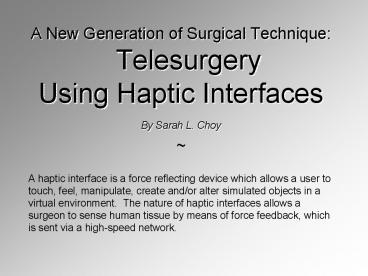A New Generation of Surgical Technique: Telesurgery Using Haptic Interfaces - PowerPoint PPT Presentation
1 / 9
Title:
A New Generation of Surgical Technique: Telesurgery Using Haptic Interfaces
Description:
A haptic interface is a force reflecting device which allows a user to touch, ... Guthart, Gary S. and Salisbury, Kenneth J. Jr. 2000. ... – PowerPoint PPT presentation
Number of Views:112
Avg rating:3.0/5.0
Title: A New Generation of Surgical Technique: Telesurgery Using Haptic Interfaces
1
A New Generation of Surgical Technique
Telesurgery Using Haptic Interfaces
- By Sarah L. Choy
- A haptic interface is a force reflecting device
which allows a user to touch, feel, manipulate,
create and/or alter simulated objects in a
virtual environment. The nature of haptic
interfaces allows a surgeon to sense human tissue
by means of force feedback, which is sent via a
high-speed network.
2
What is a Haptic Interface?Haptic comes from
the Greek meaning haptesthai, to touch
- Human-robot interaction to support physical
- manipulation of computer simulated objects
- Haptic interface comprises of
- Manipulandum operator handle, sensors
- Haptic Display mechanical, electrical and
computer hardware
3
Force Feedback
- Force Feedback
- Devices that interact with muscles and tendons
giving the sensation of force is being applied - Multi force transducers
- Strain Gauges
4
What is Telesurgery?
- Surgery via long-distance communication links
- Telesurgical workstation restores manipulation
and sensation capabilities of surgeon - Robot controlled through master will restore
dexterity and force feedback in real time - Will allow professional surgeons to perform
complex procedures with higher precision overseas
without leaving their office - Instruments designed to enter the body cavity
through - (usually 3) incisions of merely 1 cm in length
5
From Physical to Mechanical
- Surgeon
- In multimedia cockpit equipped with
stereoscopic screen and master manipulators that
sends control pulse to real-time controller - Information is sent via communication link (LAN,
ATM, satellite communication, etc.) to surgical
site - Robot
- Information is received at the surgical site
through a real-time controller and is inputted
into slave manipulators, which perform surgery on
patient - Feedback information is sent back via
communication link (back through real-time
controllers) which in turn affect master
manipulators - Throughout
- Endoscope sends visual information via
communication link from robot to multimedia
cockpit
6
Haptic Interfaces Feedback Channels
- Force feedback
- Man-machine interface that directly connects
- surgeons hands to motion of his surgical tool
- tips inside patients body
- Visual feedback
- Visual feedback provided by
- endoscope camera which transports
- 3D images in the same orientation as
- master controller and monitor
7
The da Vinci and Zeus Surgical Systems
- 7 degrees of freedom
- 3 x orientation 3 x translational grip
- Filters out surgeon tremor making tool tip
steadier than unassisted hand - Voice control allows surgeon to guide endoscope
8
From the Past to Present What the Future Holds
- 1999 ZEUS made history in the world's first
robotic-assisted beating-heart bypass surgery - September 2001 a surgeon in New York performed
gallbladder surgery on a 68-year-old patient in
Strasbourg, France. - September 2002 ZEUS was granted clearance by
Health Canada in October 2002 for cardiac surgery
and telesurgery applications - Eventually doctors may be able to use this
technology to operate on patients in dangerous or
inaccessible locations with the development of
improved high-speed networks - Use of tactile feedback, sensing heat and other
textures - Use of optoelectronic sensors instead of metal
strain gauges
9
References
- Cavusoglu, Cenk, M., et al. 2001. Robotics for
Telesurgery Second Generation Berkeley/UCSF
Laparoscopic Telesurgical Workstation and Looking
Towards Future Applications. Proceedings of 39th
Allerton Conference on Communication, Control
and Computing. - Centre for the Integration of Advanced Medicine
and Innovative Technology. 2003. Future
Perspective. Website Accessed February 10,
2004 lthttp//www.camit.org/english/future_pers.ht
mlgt - Computer Motion. 2002. Zeus Surgical System.
Website Accessed February 10, 2004
lthttp//www.computermotion.com/productsandsolutio
ns/products/zeus/gt - Guthart, Gary S. and Salisbury, Kenneth J. Jr.
2000. The IntuitiveTelesurgery System Overview
and Application. Pro. IEEE. ICRA. - Intuitive Surgical Inc. 2003. da Vinci Surgical
Systems. Website Accessed February 10, 2004
lthttp//www.intuitivesurgical.com/productsgt - Mitsuishi, Mamoru, et al. 2003. Development of a
Remote Minimally-Invasive Surgical System with
Operation Environment Transmission Capability.
Pro. IEEE. ICRA. - Tavakoli, M., et al. 2003. A Force Reflective
Master-Slave System for Minimal Invasive
Surgery. Pro. IEEE. International Conference on
Intelligent Robots and Systems.

